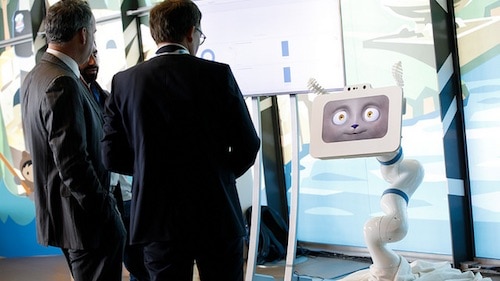Artificial intelligence (AI) promises to transform business processes and productivity across industries and the economy as a whole. But unless businesses rethink how their people can work in partnership with intelligent machines, there’s a risk that this promise will quickly pass them by.
According to Jim Wilson, Managing Director of Information Technology and Business Research at Accenture Research, the most lasting, impactful performance boost happens when people and AI-powered machines work together to create “collaborative intelligence.”
Wilson, who conducted research with more than 1,000 global companies to co-author Human + Machine: Reimagining Work in the Age of AI with colleague Paul Daugherty, found that if AI is deployed primarily to displace human workers, short-term productivity gains are about as good as it gets. “Such improvements eventually stall. As Elon Musk said, ‘Excessive automation at Tesla was a mistake. Humans are underrated!’”
By contrast, Wilson’s research found that enterprises that reimagine work around human and AI collaboration outperform those that focus solely on automation by more than three times — and often, by more than six times — in areas like speed, scalability, flexibility, and decision-making within processes.

So if unlocking AI’s power rests on enabling effective collaboration between humans and machines, how should business leaders redesign processes to support such a partnership? And what actions should they be taking now to prepare their workforces for the impact of AI, while minimizing workforce disruption?
Machines assisting humans — and vice versa
A first step is to understand how humans and AI can actively enhance each other’s capabilities.
Wilson believes business processes must be designed around the “relative strengths” of smart machines and humans. That means taking into account humans’ grasp of such qualities as leadership, teamwork, creativity, and judgment, alongside the exponential speed, scalability, and quantitative capabilities of machines.
“Humans’ strengths will come into play as they perform three crucial roles — training machines to perform certain tasks, explaining the outcomes of those tasks, and sustaining the responsible use of machines (for example, by preventing robots from harming humans),” he said.

“At the same time, we don’t want to put machines to work in business domains that they’re not strong at. For example, say your company wanted to go after a totally new market for a product. Logically, you wouldn’t have much data available in such a scenario, and so a machine wouldn’t be at all effective at coming up with a creative new product concept.”
He cites the case of BMW, where integrated teams of robots and humans are leading to productivity gains. “BMW has reimagined its automated assembly lines at its Spartanburg, South Carolina, plant as flexible assemblages of humans and AI-enabled robots,” he said. “We found that as a result, these human and machine teams are about 85% more productive — and much more flexible” than either humans or robots working alone.
Empowering workers to use AI will minimize job displacement
Getting people and AI-enabled smart machines to work together doesn’t just deliver great business results, according to Wilson. Such an approach can also help to minimize upcoming disruption to the workforce. “That’s because the workers that are most at risk of displacement are the ones that aren’t using the technology,” he said. “It’s the workers who use AI who will replace those who do not.”
Getting more people to use AI is therefore crucial. Wilson suggests that companies focus on reducing the barriers to using AI. “Adopting easy-to-use ‘point-and-click’ type AI or machine learning tools, for example, can really help to democratize AI,” he said.
“With these, you just download an API and upload your data. Say you’re a marketer — these kinds of tools can make it easy to perform tasks like cluster analysis, anomaly detection, or regression to find new customer segments. Or say you’re working in a warehouse. You can use AI to deal more efficiently with your inventory management.”
Upskilling workers for the AI age
Wilson also believes most activities at the human-machine interface will require people to do new and different things (train a chatbot, for instance), and to operate differently (deploy that chatbot to provide better customer service). So companies must also think more creatively about the skills that people will need and the training offered to them.
However, Accenture’s researchers found that only a small number of companies have begun to develop strategies to help employees gain the new skills they need to exploit the power of AI.
“We found that while 67% of companies recognize that there is a growing skills gap, only about 26% of senior executives believe their people are ready to work with intelligent technologies,” Wilson said.
Another study found that while two-thirds of U.S. hiring managers believe that implementing workforce development programs will help them prepare for future disruptions or innovations, many businesses have been slow to act.
As Wilson points out, companies are often held back by budgetary constraints, lack of time for employees to participate in training, and lack of appropriate training technology.
“Many are also waiting to see what others are doing, or when they do invest in reskilling, it’s only in small pockets — reskilling their analytics team to become better at machine learning, for example,” he said. “However, any reskilling investment has to be systematic and enterprise-wide if companies are to avoid future skills shortages.”
Four-step approach to AI upskilling
Wilson suggests business leaders consider a reskilling framework based on the following key considerations:
- Reimagine what’s possible. “Companies must encourage an open mindset among employees to ensure they trust — rather than fear — applying automation to their various routine tasks,” said Wilson. “The ability to experiment and create tests to derive business processes that work is also critical.”
- Enable data literacy. Data fuels most AI systems, so basic data literacy should be an integral part of any upskilling program. “Employees will need to understand your company’s data policy, for instance,” said Wilson. “They will also need some data ethics skills to cocreate and collaborate with AI systems and understand why it’s more important to obtain the right data than the most data.”
- Democratize AI. Companies already experiment with a range of new user interfaces, including natural language processing and collaborative robotics. “Training programs should democratize AI learning by ensuring all stakeholders understand how to interact with such systems,” said Wilson.
- Commit to responsible AI. Skills training for the age of AI isn’t simply a technical affair — it has a social and ethical dimension as well. “There’s a leadership imperative to build AI systems responsibly,” said Wilson. “That means ensuring that executives commit to using AI in a way that is transparent, accountable, and free from biases.”
Upskilling for AI is a business responsibility
In Wilson’s view, those who warn that robots are taking over fear the wrong threat. Rather, by working to create a culture of continuous learning to help people work with AI-enabled smart machines, businesses can help build a new economy that gives more people an opportunity to prosper.
“Business has a responsibility to upskill workforces for the AI age — a role that cannot fall only on governments,” he said. “It’s a role that involves both an economic incentive (to ensure a ready supply of talent) and a moral obligation (to ensure the benefits of AI are more evenly distributed). If we want to increase the effectiveness of any human-machine collaboration, then increasing the effectiveness of education is a vital component. Success in AI is intricately tied to an investment in people.”




























